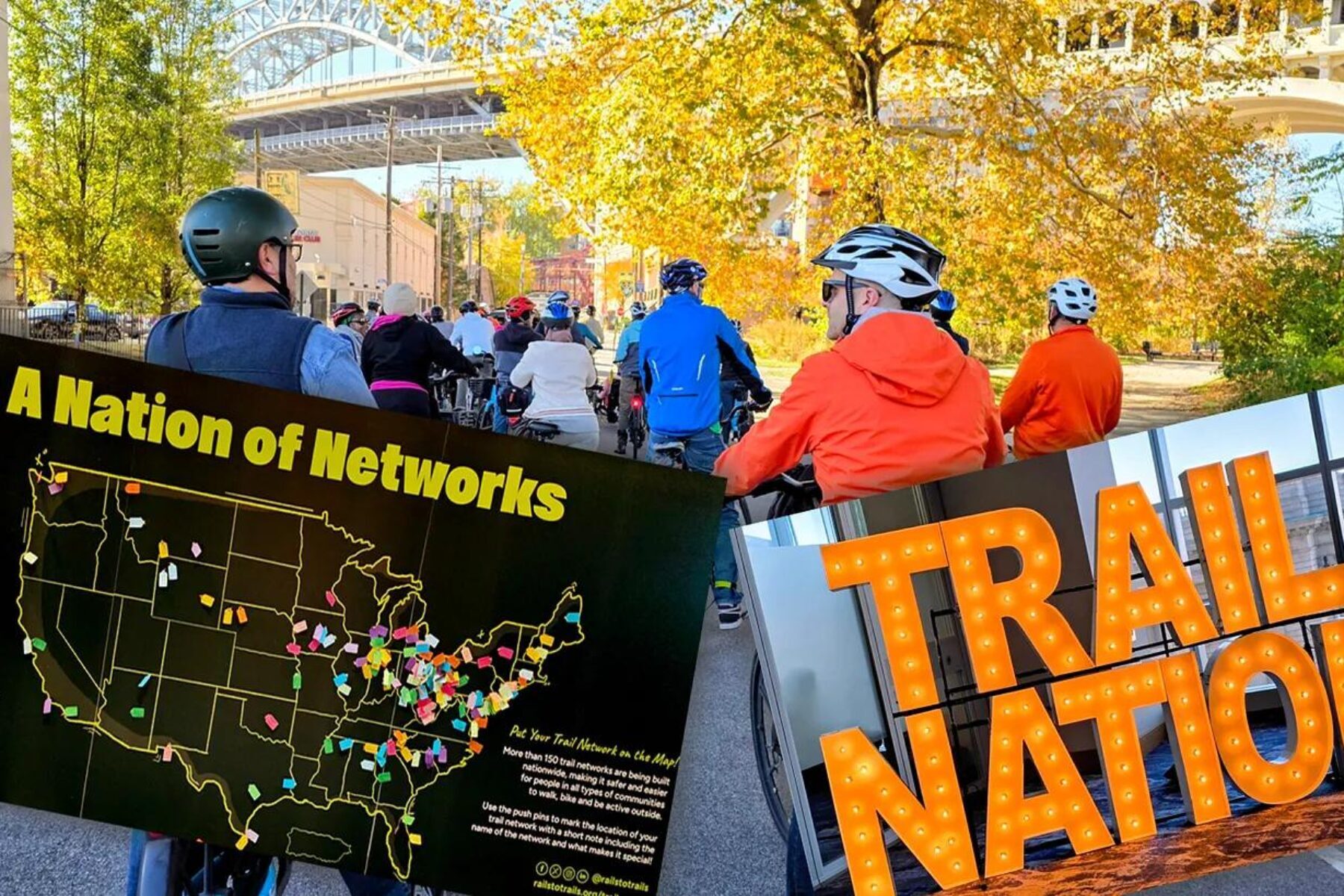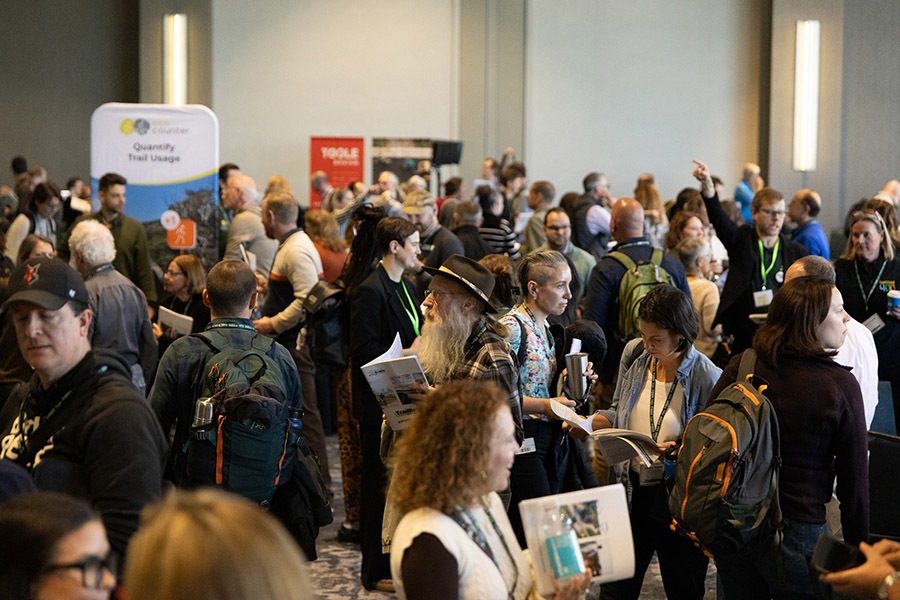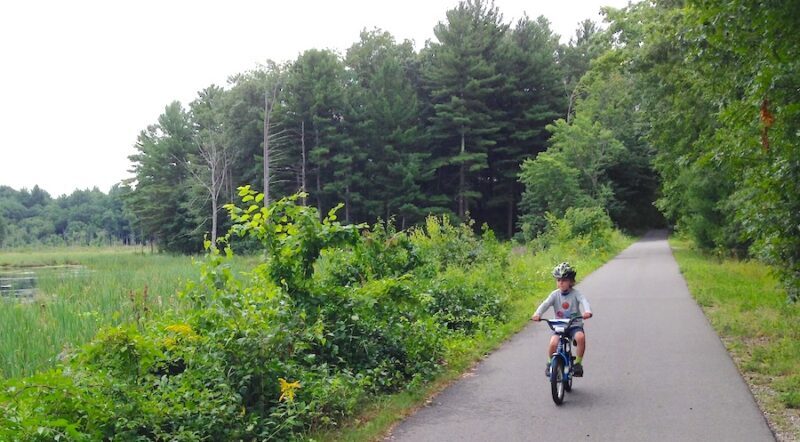What I Learned Speed Dating for Trails

Six Quick Conversations at the 2025 TrailNation Summit World Café That Left a Lasting Impact on How I See Trail Advocacy
One of the more unique and engaging sessions at the Rails-to-Trails Conservancy’s 2025 TrailNation™ Summit in late October was the World Café, the first breakout after the opening day’s plenaries on Oct. 28. Earlier that morning, over breakfast, I flipped through my summit workbook, scanning 20 rapid-fire, round-robin small group breakouts. The challenge ahead was choosing six topics that spoke loudest to me and promised the biggest bang for the buck.
Think of this as a kind of speed dating, a rapid-fire matchmaking process where I had a few minutes to choose an expert and gather their trail wisdom. It wasn’t so much about meeting and networking (though that happened) as it was about connecting with new ideas, fresh perspectives and practical solutions that fed into concepts quietly simmering in my mind.
At the TrailNation Summit World Café, it was about taking a fresh look at familiar ideas or discovering something completely unexpected to help blaze a better trail forward.
Note: This article was original published on the Tom on the Trails blog on Nov. 10, 2025. It has been published here in an edited format with permission.
A Fast-Paced Exchange of Ideas

Each of the six round robins was fast-paced and energizing. Experts had just a few short minutes to introduce their ideas, spark conversation and light a fire in minds before the bell sent us on our way to the next table.
This was a refreshing break from the all-too-familiar PowerPoint marathons, where speakers cram a day’s worth of content into 45 minutes of overpacked slides. This format encouraged concise storytelling with real engagement and active thinking.
As an avid note-taker, I found it challenging to keep up. I walked away from each one with highlights and a key takeaway to inspire me to take action and challenge how I think about trails, communities, businesses and other partners along the trail.
Over the past week, I revisited my workbook notes. The six topics I chose were diverse, yet together they reflected what I value most as a trail leader: connections, inclusion, sustainability and local pride.
Here’s what stood out at the 2025 TrailNation Summit World Café.
I walked away from each [World Café table] with highlights and a key takeaway to inspire me to take action and challenge how I think about trails, communities, businesses and other partners along the trail.
—Tom Bilcze, 2025 TrailNation Summit attendee and Ohio trail leader
Outdoor Recreation and Rural Prosperity

My summit cohort, a group of attendees who shared a common thread, focused on rural communities. It was a natural fit from two perspectives: I live in rural Ohio on a family farm, and I lead a trail that runs through numerous rural towns and country crossroads as it diagonally crosses the State of Ohio.
The speaker at the Outdoor Recreation and Rural Prosperity table, Trisha Purdon from the Kansas Office of Rural Prosperity, shared a simple but powerful message that resonated with me: “The outdoors is everything. Find a place in it. Understand the culture of the community.”
Kansas fosters community champions in small towns to energize the local economies and restore rural community pride. These state-community partnerships fund and make that magic happen. Part of that formula is connecting the town to the outdoors and trails to invigorate the downtown, the heart of rural America.
My key takeaway: Rural small-town Ohio is often overlooked and left behind, but trails can serve as a catalyst for renewal when residents are empowered to take the lead. It’s something worth advocating for as a rural Ohioan.
Signage and Branding to Unite Your Trail System

Few challenges are as universal as signage and identity. When local trails join larger regional or statewide networks, signs become the gateways where consistency matters. Trail visitors want clear, recognizable, consistent signage, yet local communities tend to cherish their unique signage.
The solution isn’t one-size-fits-all, a theme touched on by Cathy Fromet and Erica Deutsch of Guide Studio. It’s collaboration and compromise. Each trail partner must respect local identity while building awareness of the larger network identity. When balance is found, the trail becomes more than a local asset. It becomes the connection and invitation to visitors crossing the trail network to step inside.
My key takeaway: I’ve watched this dialogue and local–statewide collaboration take shape and gain momentum. Challenges remain, but as more see the return on investment of the outdoor economy and tourism, the importance of a well-signed statewide trail network becomes clearer.
Marketing Strategies to Maximize Trail Networks

Trail leaders have focused on building and maintaining trails for many years. As a trail network becomes interconnected with more miles for relaxation, recreation, exploration and adventure, marketing cannot be ignored.
In the Marketing Strategies to Maximize Trail Networks table, the facilitator, Outright, provided Fayetteville, Arkansas, as a notable example and blueprint to learn from and follow. The success of their marketing came from identifying their target audience, refining their message and measuring results. They did this by utilizing social media and marketing analytics software and experts.
For smaller trail communities with limited budgets, the lesson is clear: Know your audience, speak their languages, and measure what matters. Low-tech approaches such as talking to visitors, conducting surveys and listening in on social media reveal valuable insights.
My key takeaway: By using targeted marketing and tracking the results, both low- and high-tech communities can demonstrate a strong return on investment and build a compelling case for continued trail support.
Engaging Black Women, Girls and Families in the Outdoors

This session reminded me that inclusion doesn’t just happen but is nurtured. Early on, She is Focused founder Ajoa Abrokwa said something that stuck with me: “Land is not just a place we visit, but one we nurture.”
That means taking an honest look at where we fall short in creating opportunities for everyone. To make trails truly welcoming, we need to remove barriers, build partnerships and design programs that reflect diversity in leadership, on the ground and in the stories we tell about our trails.
It’s about meeting people where they are: hosting inclusive events, partnering with groups that reach broader audiences and creating trail experiences that foster a genuine sense of belonging. By bringing these conversations into outdoor spaces, we open the door for everyone to feel welcome.
My key takeaway: As a statewide trail leader, this session renewed my commitment to ensuring our trails are places where everyone belongs. The outdoors is free, and there should be no barriers to experiencing the freedom that trails provide.
Engaging Local Foundations for Trail Success

Funding is a challenge familiar to every trail organization and advocate. This session led by Elizabeth Lynn of the van Beuren Charitable Foundation focused on understanding local philanthropy and aligning trail goals with funders’ passions. Funders give when the trail mission speaks to and reflects their mission of giving.
Trail organizations must learn what drives their potential partners and shape proposals that connect emotionally and strategically. Understand where the funder is coming from and what makes them tick, and focus on what they are enthusiastic about.
My key takeaway: This had me thinking about how my statewide trail can help local groups build those grantor-grantee relationships. We need to be a bridge that closes the trail needs and trail funding gap.
Activating and Measuring the Economic Impact of Trails

This session by Fourth Economy’s Nicole Muise-Kielkucki and Justin Wheeler truly resonated with me. I’ve long championed the Trail Town concept —the idea that communities should embrace their trail as a defining part of their identity, using it to strengthen the local economy through tourism and to welcome visitors.
When trails welcome visitors, they bring spending, pride and a sense of community ownership. For that momentum to last, residents must see and believe in the impact. It starts by examining the local economy as it stands and understanding how it connects to the trail. The mutual benefits and opportunities between the trail and the town become clear through that lens.
Trail advocates, civic leaders and business owners must work together to demonstrate the shared value that drives greater economic impact. Locals play a crucial role in that story. Their voices and actions give the trail and town credibility and authenticity. When that happens, a true partnership follows.
My key takeaway: The more voices at the table in a trail town, the stronger the shared value proposition, and that collaboration opens doors to funding, visibility and growth in many ways. That’s a message I need to preach.
Lessons From My Trail Matchmaking Dates
In the end, my speed-dating experiment paid off. Each “date” left me with new insights and renewed enthusiasm for trail advocacy. Some ideas resonated immediately; others challenged me to see things differently. Together, they reminded me that trails are more than just in their building. It’s about fostering and growing relationships between people, places and possibilities.
Just like in real speed dating, not every encounter leads to a lasting match, but the ones that do can change everything.
Happy Trails!

Donate
Everyone deserves access to safe ways to walk, bike, and be active outdoors.


